The dumbbell row, also known as the single-arm dumbbell row, is one of those exercises that we hope stays in style. It’s also simple as heck to do — you kneel on a bench and row your arm to your side — and it requires just a dumbbell to load the movement.
There’s a reason bodybuilders like Arnold Schwarzenegger and powerlifters like Janae Kroczaleski make dumbbell rows a mainstay in their routines. They’re extremely effective at both growing and strengthening the muscles in your upper back. We want you to love the dumbbell row, too, which is why we put together this comprehensive how-to guide.
Video Guide
If you’re a visual learner, look no further than this in-depth dumbbell row guide, featuring BarBend former Training Editor Jake Boly.
How To Do the Dumbbell Row
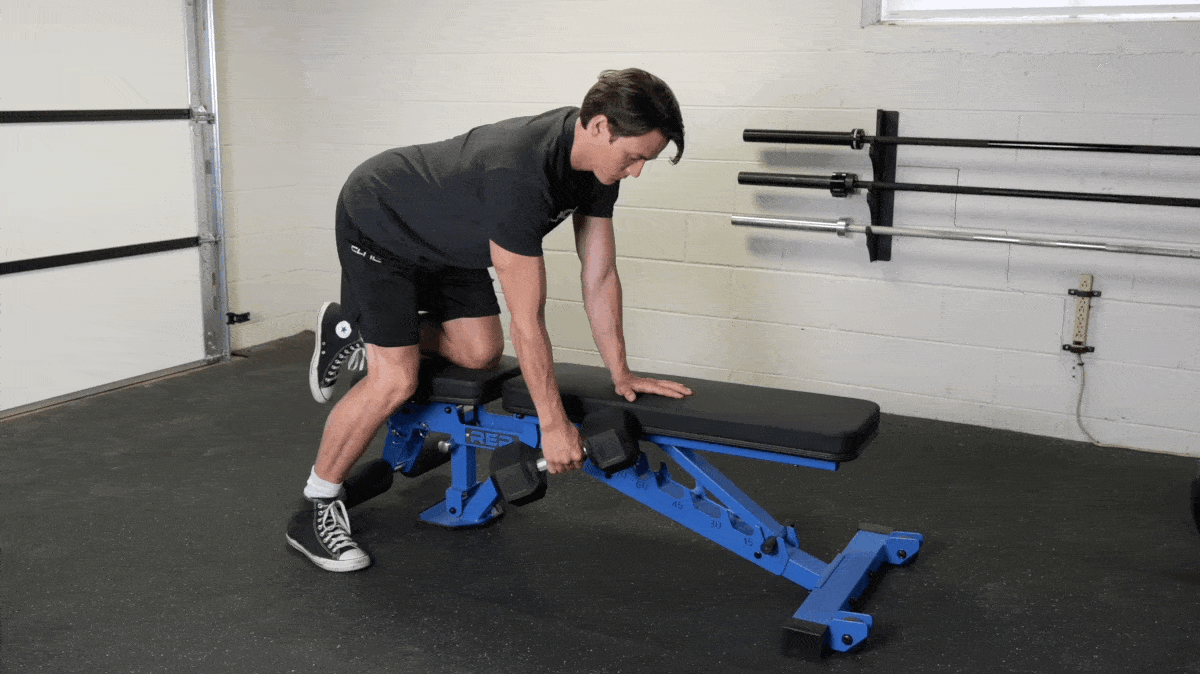
[Read More: Row Variations to Build a Stronger and Thicker Back]
- Step 1 — Stand next to a weight bench and place a dumbbell next to it on the side you plan to row. Place your non-rowing hand and your same-side knee on the bench, with your other foot firmly planted on the ground.
- Step 2 — Flatten your back and brace your core, then reach down to grab the dumbbell with your working arm and lift it off the ground a hair.
- Step 3 — Perform the dumbbell row by pulling your elbow up and back while keeping your upper arm tucked tightly to your side.
Modifications
- Make It Easier: You can adjust the seat of an incline bench up high so you can brace on your elbow rather than your palm.
- Make It Harder: Try pausing at the top of each repetition.
Dumbbell Row Variations
There are plenty of dumbbell row variations you can incorporate into your workouts if the standard exercise isn’t working for you. Here are a couple of options to modify the dumbbell row in order to gain more muscle, build more strength, or improve your comfort:
Dead-Stop Dumbbell Row
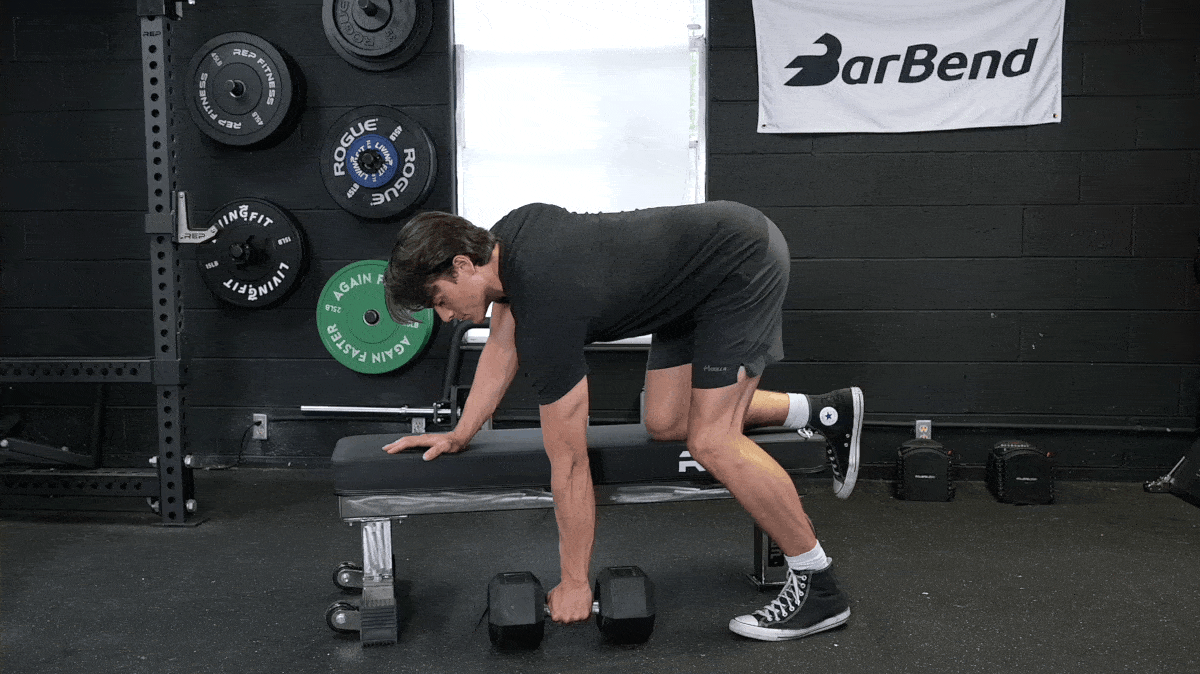
[Read More: Learn the Best Single-Arm Row Variations for Absurd Upper Back Strength]
- Set up as you would for a regular dumbbell row with the weight on the floor next to a bench.
- Place your non-working hand and knee on the bench and hinge over with your working arm hanging down toward the dumbbell.
- Grab the dumbbell, brace your core, and row it upward in one swift motion. Deliberately pull the weight explosively.
- Allow the weight to fall back down to the floor, but maintain control of it. Reset yourself, take another breath, and row again.
This variation is excellent for training power and moving more weight than you can use with a standard dumbbell row. Go for this variation if you want to be more athletic or really need to get your blood pumping.
Chest-Supported Dumbbell Row
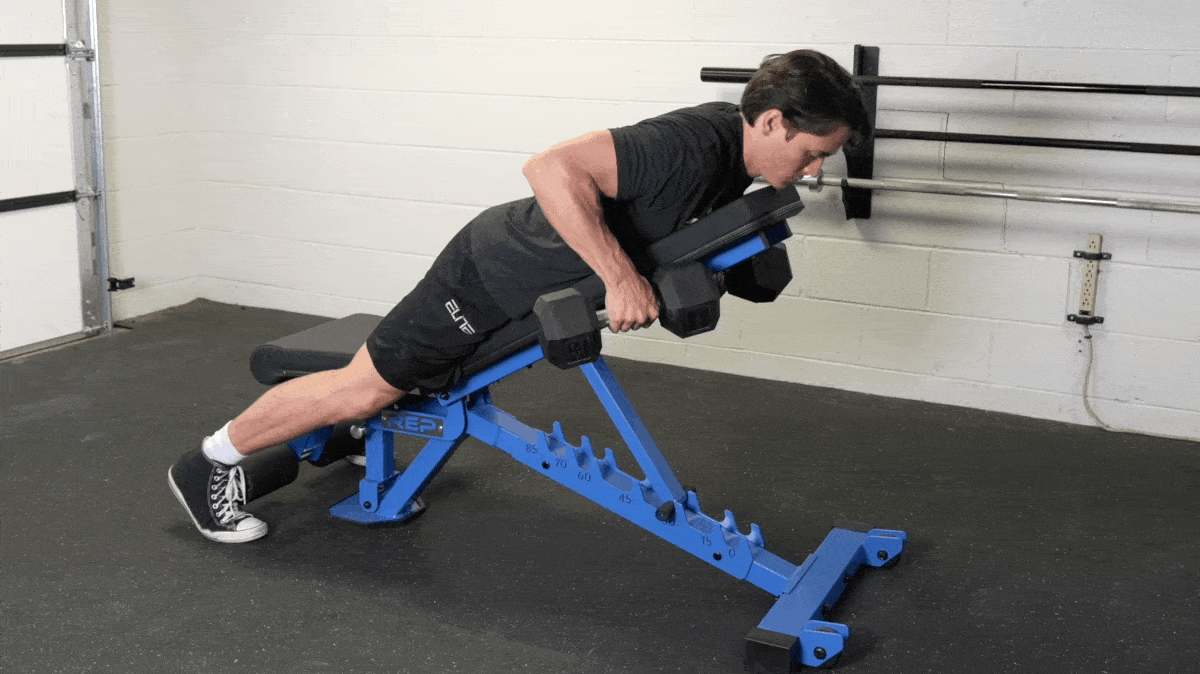
- Set an adjustable weight bench between 20 and 40 degrees.
- Lie stomach-down on the bench with a dumbbell in either hand hanging freely downward.
- Inhale and row the dumbbells up and back by leading with your elbows. For an extra challenge, pause for a moment at the top.
Do this dumbbell row variation if you want to prioritize muscle growth, or if you want to minimize the load placed upon your lower back. The chest support removes the requirement of stabilizing your torso so you can focus solely on contracting your back muscles.
Dumbbell Row Alternatives
Dumbbell rows are great, but they aren’t for everyone. There are a whole host of other back-building movements you can do if you don’t enjoy the exercise or don’t have access to a pair of dumbbells.
Barbell Row
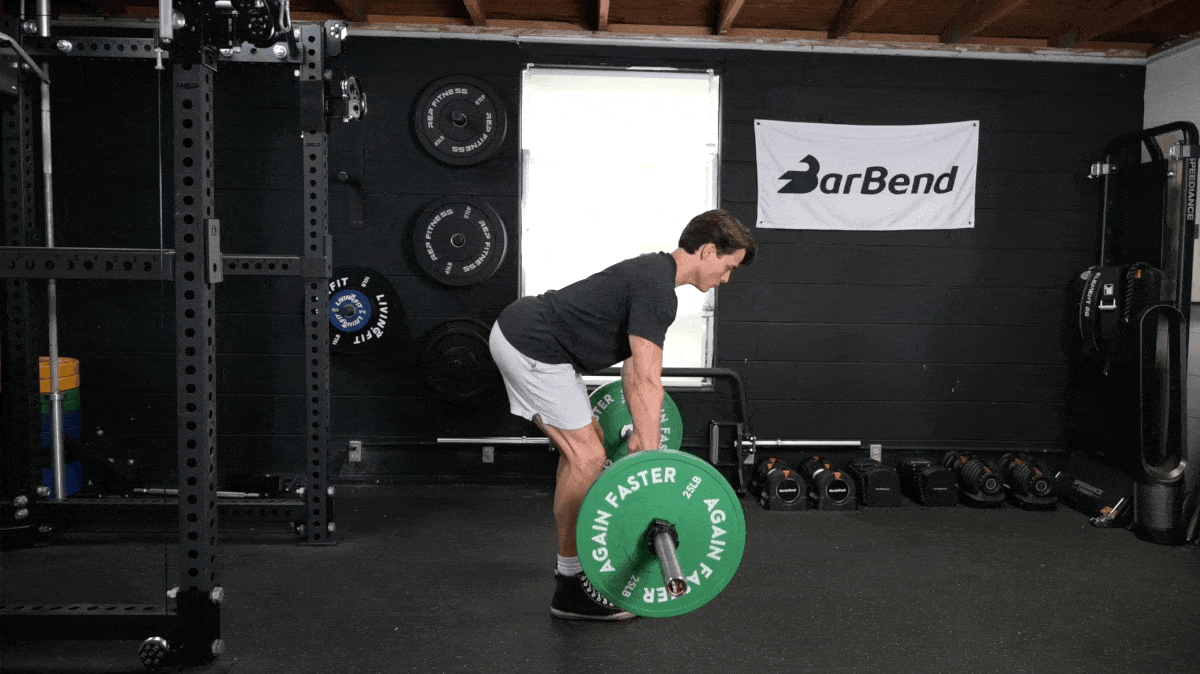
[Read More: Barbell Row Vs. Dumbbell Row — Which Is Best for Strength, Hypertrophy, and Fitness?]
- Stand upright while holding a barbell with a double-overhand, medium-width grip, and your feet under your hips.
- Perform a hip hinge and bend over, allowing the bar to slide down your thighs until it is right around your knees.
- Brace your core and row the bar up and back towards your belly, without changing the angle of your torso.
Barbell rows are fantastic for building total-body strength and engaging the various muscles along your posterior chain. You can also work with the barbell instead of dumbbells if you’re in a rush and need to save time in the gym.
Modifications
- Make It Easier: Use straps and a lifting belt to support your back and secure your grip.
- Make It Harder: Tip over until your torso is fully parallel to the floor.
Seal Row
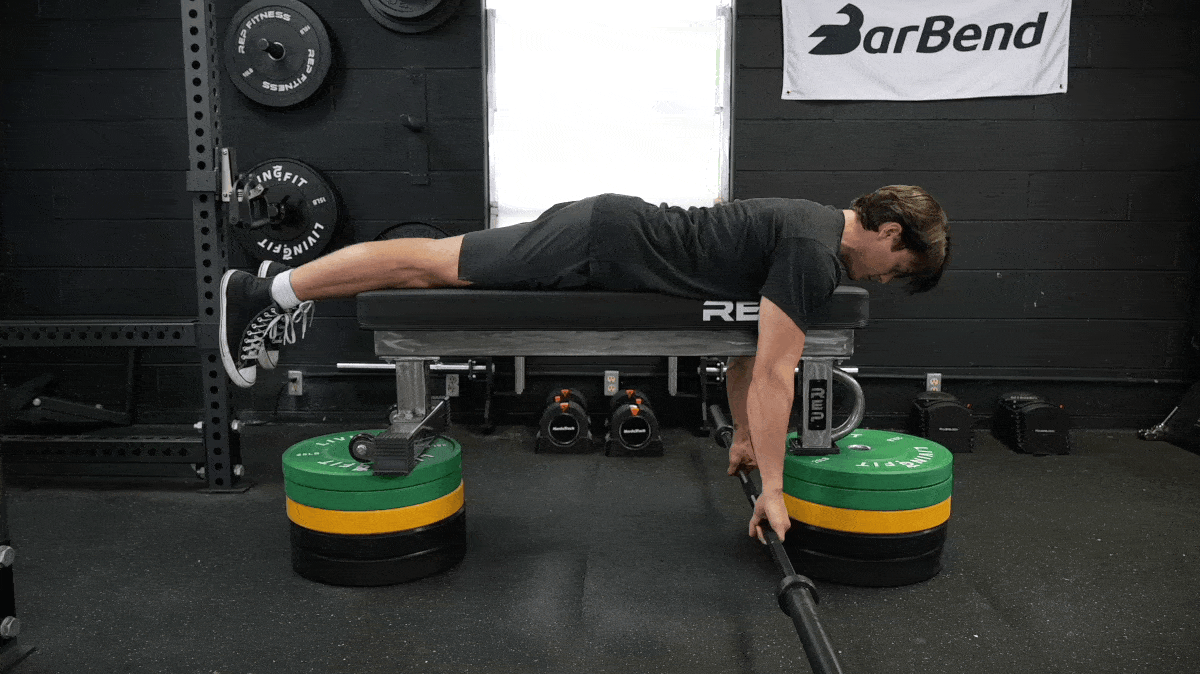
- You’ll need to stack a flat weight bench atop several bumper plates or two plyo boxes if you don’t have a seal row station available.
- Lie flat on the bench with a barbell underneath. If you want to load the barbell with weight plates, make sure to elevate the bench further.
- Grab the bar with your preferred rowing grip, brace your core, and pull it up towards the underside of the bench.
Seal rows can be tricky to set up, but are fantastic for isolating your back muscles without straining your lumbar spine or hips. They make for a great alternative to the dumbbell row if you prefer working with both arms at once but want to prioritize back gains exclusively.
Modifications
- Make It Easier: You can do this move with dumbbells if you want to cut down on setup time.
- Make It Harder: Pause at the top of each repetition with the bar against the underside of the bench.
Meadows Row
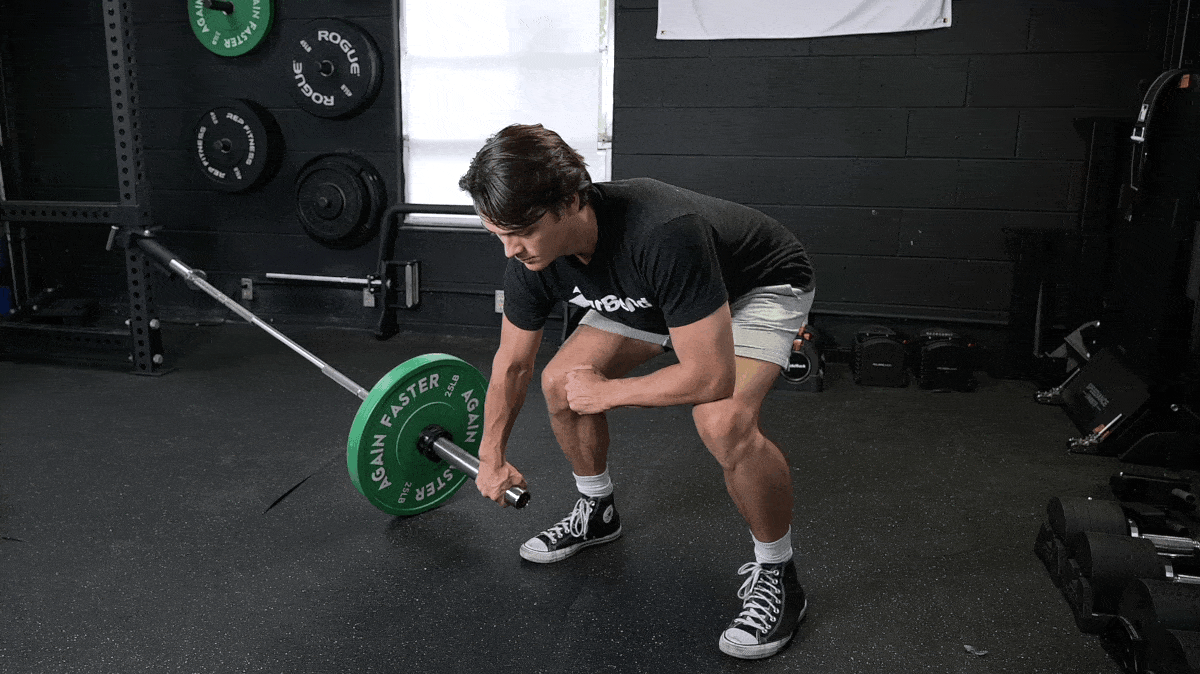
[Read More: How to Do the Reverse-Grip Bent-Over Row for Bigger Lats and Beefier Biceps]
- Fix a barbell into a landmine base or wedge it into the corner of a wall.
- Grab the end of the sleeve of the bar and stand sideways to it.
- Bend over and then row the end of the bar up and backward, contracting the muscles in your upper back.
This exercise is named after legendary bodybuilding coach John Meadows. You can use this one if you don’t have dumbbells available but still need to isolate one side of your back at a time.
Modifications
- Make It Easier: You can kneel your far leg on a flat bench for stability.
- Make It Harder: Try staggering your stance or using a B-stance posture to challenge your balance.
Dumbbell Row Sets and Reps
An exercise is only as good as how you perform it. How many sets and reps should you do on the dumbbell row? Well, it depends on your goals. Here are a few programming prescriptions for the dumbbell row for you to try:

[Read More: Upright Row With Dumbbell: Muscles Worked, Exercise Video, and Benefits]
- To Gain Muscle: Try performing 3 to 4 sets of 8 to 12 repetitions with a moderate to heavy load.
- To Build Strength: Go heavy and do 4 to 5 sets of 6 to 8 reps of dumbbell rows with a heavy weight. Don’t be afraid to use lifting straps!
- Your First Time: If you’re just starting out with the dumbbell row, keep it simple and do 3 sets of 10 reps.
Benefits of the Dumbbell Row
Here are three benefits you’ll get from adding the dumbbell row into your training routine.
Stronger Back and Grip
The dumbbell row is a key back-building exercise for lifters, athletes, and general fitness-goers alike. You can do dumbbell rows to develop back strength and muscle hypertrophy, with additional benefits of improved grip strength and biceps development when done in higher training volumes.
Improved Posture
The dumbbell row can help to increase back strength and posture, as it develops many muscle groups that retract the shoulder blades. Individuals who slouch, sit at a desk, and round forward during sets of deadlifts can all integrate back exercises like the single-arm dumbbell row to help strengthen the back and improve their posture.
Application to Competitive Strength Lifts
The dumbbell row targets the back, grip muscles, and arms. Those muscle groups are responsible for assisting in movements like squats, deadlifts, bench press, and maintaining positional strength in Olympic lifts. Stronger back muscles can ultimately lead to better performance overall.
Who Should Do Dumbbell Rows?
The dumbbell row is a very versatile movement. Whether you’re a bodybuilder trying to build muscle, or you’re trying to strength train for general health, you can use the dumbbell row to achieve your goals. Before you include the dumbbell row in your workout plan, check to see if you fall into one of the following categories:
- Bodybuilders: Those trying to build muscle can use the dumbbell row to isolate their lats and traps without incurring too much stress on the lower back in the process.
- Strength Athletes: A strong upper back is essential for performing well in sports like powerlifting or strongman. Most strength sports are barbell-only, so you’d do well to include some other equipment as part of your accessory training.
- General Populations: Studies repeatedly show that unilateral exercises are invaluable for preventing and managing muscle imbalances, as well as helping to heal injuries. (1)(2) If you’re hitting the gym for general health and wellness, an exercise like the dumbbell row is a must-do move.
Muscles Worked by the Dumbbell Row
The dumbbell row is a back exercise that stresses high amounts of muscle tissues when performed correctly in the back, biceps, and forearms. The list below covers the primary and secondary muscles worked when performing dumbbell rows.
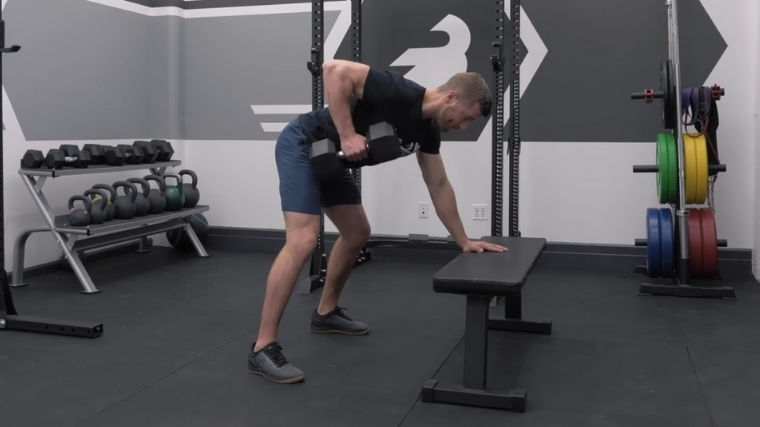
Latissimus Dorsi
The lats are a large triangular muscle that spans the entire length of your back. A strong back helps you in nearly every single endeavor as a lifter (and an upright human).
Spinal Erectors
The spinal erectors, aka the lower back, work to assist in stabilizing the spine during the dumbbell row, as you maintain a forward hinged-over position for the duration of the exercise. Note: If you brace yourself on a bench, your lower back won’t be as involved. To better engage your lower back, try performing the single-arm dumbbell row without any support.
Scapular Stabilizers
Single-arm dumbbell rows require that your shoulder blades (aka the scapula) are squeezed together to prevent your shoulder joints from moving. Since they’re contracted for the duration of the exercise, the smaller stabilizer muscles of the scapula gain a lot of strength. Considering strong and stable scaps are important for just about every pulling exercise, it’s an important area to target.
Forearms and Biceps
The muscles or the arm work to grip the dumbbell and assist in the pulling movement (elbow flexion). Note that a proper row should not use the biceps to initiate the movement, but rather that lats. That said, high rep rows can work to build arm strength and muscle development.
Common Dumbbell Row Mistakes
The key to maximizing your time in the gym is to maximize your technical proficiency. In simple terms, perfecting your form. To make sure you’re using picture-perfect dumbbell row form, steer clear of these common mistakes:
Twisting Your Torso
When you perform dumbbell rows, make sure that you aren’t rotating your torso as you pull. The hallmark of a sloppy dumbbell row is one that utilizes too much momentum and involves twisting your working shoulder up toward the ceiling.
Rowing Too High
The dumbbell row works your latissimus dorsi muscles more than any other. These large muscles in your upper back function to pull your upper arm in towards your torso. Proper dumbbell row form involves driving your elbows back, not shrugging your shoulders. When you perform dumbbell rows, think about “leading with your elbows” and pulling the weight into your lower stomach.
Not Using Straps
Dumbbell rows don’t necessarily require lifting straps, but remember that they aren’t a grip exercise. If you find that you can’t hold onto the weight you’re using, but your back still has some energy, you might benefit by strapping up. This will allow you to row heavier without being limited by your forearms.
Frequently Asked Questions
What muscles do dumbbell rows work?
The dumbbell row is a unilateral back exercise. It targets your latissimus dorsi, traps, rhomboids, and biceps, but also works your core to a small degree.
What is the benefit of doing a one-arm row vs. a two-arm row?
Performing two arm rows allows you to train the back in less time. However, the one-arm row allows you to often train with heavier loads, train closer to failure, and not be limited by hamstrings and lower back positional strength (as you can use your other arm as a support structure).
If you find you do rows but do not feel the back muscles fatiguing out first (not the lower back, but the middle and upper back muscle fibers), try one-arm rows in a supported position. If you want to do two-arm rows, try performing the chest supported two-arm row option from above.
What’s the best method to build muscle with dumbbell rows?
Do sets of 15 to 30 reps with moderate weight. If you can perform more than 30 reps with ease, the weight is too light. For best results, try to perform perfect reps to complete failure, with no more than 20-30 reps per set. If you can do more than this, try adding some weight or add pauses and slow-tempo reps.
How heavy of dumbbells should you use for dumbbell rows?
There’s no specific weight you should start with, since everyone has their own strength levels. That said, you can lift heavy on the dumbbell row as long as you aren’t feeling forced to twist your torso or rely on momentum to heave the weight up.